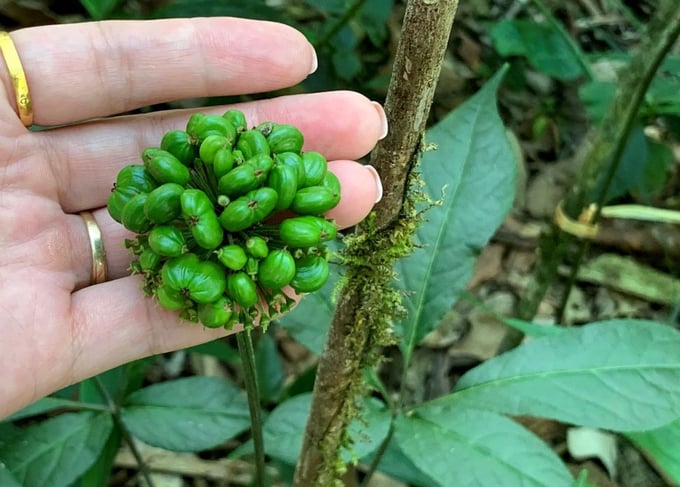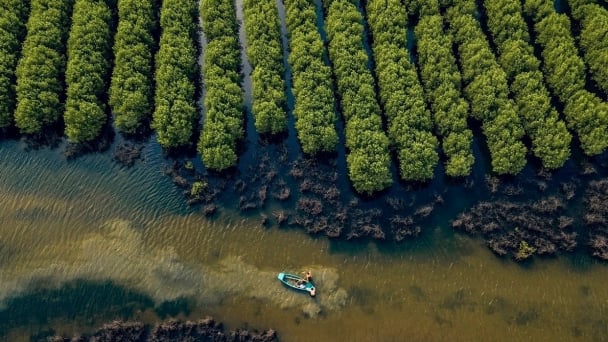June 17, 2025 | 04:35 GMT +7
June 17, 2025 | 04:35 GMT +7
Hotline: 0913.378.918
June 17, 2025 | 04:35 GMT +7
Hotline: 0913.378.918

Chairman of Lai Chau Province People's Committee Tran Tien Dung visit a ginseng farm. Photo: HD.
The northern mountainous province of Lai Chau is located in the upstream province of the Da River, which regulates and supplies water for daily life and production for the downstream region and especially for national hydroelectric projects such as Lai Chau, Son La, and Hoa Binh. Thus, the Forest area in the province plays an important role in national defense and security.
Forests also create favourable conditions for forestry, medicinal, and fishery production.
The whole province of Lai Chau currently has over 520,000ha of forestry land, accounting for 57 per cent of the total natural area of the province. Of the forest land, the special use forest area is over 41,000 ha (accounting for 8 per cent), the protection forest area is 265,000 ha (accounting for 51 per cent), and the production forest area is over 213,000 ha (accounting for 41 per cent).
Lai Chau province has determined that sustainable forest development is an important task, so much attention has been paid to forest management, protection, and development.
Up to now, the annual forest cover rate of Lai Chau increased and has reached nearly 51 per cent, bringing great benefits in terms of environment, water resources, and the cost of paying for forest environmental services. Over 70 per cent of households participating in afforestation and forest protection have a stable income.
The province has also promoted the development of the forest economy through the formation of concentrated commodity production areas with high-economic-value trees.
Many rare and precious medicinal herbs with high economic value are preserved and developed by the local people. For example, Lai Chau ginseng, a seven-leaf one-flowered plant, tinsel orchid, tam thất (False ginseng ), cardamom, and hà thủ ô (multiflorous knootweed).
Forest development and forest economy have made important contributions to the provincial socio-economic development, ensuring the national defense and security of Lai Chau province for years.

Fruit and seeds of precious Lai Chau ginseng. Photo: BT.
Duong Dinh Duc, Director of the Department of Science and Technology of Lai Chau province, said that from 2014, the department advised the People's Committee of Lai Chau province to carry out a ministry-level project on Lai Chau ginseng "Research on building propagation and planting process of Lai Chau ginseng" and province-level project "Research on conservation and development of Lai Chau and wild Tam Thất species in remote communes of Muong Te District".
After years, research and conservation efforts showed that Lai Chau Ginseng (Panax vietnamensis var, fuscidiscus K.Komatsu, S.Zhu & S.Q.Cai) has a particularly rare genetic resource not only in Vietnam but in the world. It is found only in Lai Chau province. All parts of the plant can be used as medicine.
The saponin content in the samples of Lai Chau ginseng collected in the wild averaged about 23-27 per cent, and the total saponin content increased gradually with the number of years. In particular, the content of Majonoside - R2(MR2) accounts for 4-6 per cent.
The Department of Crop Production under the Ministry of Agriculture and Rural Development granted it Plant Variety Protection Certificate as ginseng is a native plant, very suitable for the soil and climate of Lai Chau province.
The People's Council of Lai Chau province issued Resolution No. 38/2019/NQ-HDND on December 11, 2019, approving the project on the development of some medicinal plants in the period of 2020 - 2025, with a vision to 2030 in the province to offer further development orientation and supports.
In particular, the project offers support on varieties, fertilizers, and pesticides to support conservation, complete the process, and propagate according to scientific research topics approved by competent authorities. It also supports the consumption of ginseng.
Up to now, Lai Chau has had many businesses, cooperatives, households, and individuals in the province boldly invested and planted more than 15ha of Lai Chau ginseng in the districts of Muong Te, Sin Ho, Phong Tho, and Tam Duong.
Ginseng farming has been creating opportunities to help people and ethnic minorities in remote, isolated, and border areas step by step escape poverty and get higher income sustainably.
The province also proposed to the Government to soon approve the pilot project to hire forest environmental services to plant medicinal herbs under the forest canopy. Currently, the Ministry of Agriculture and Rural Development planned to pilot the leasing of forest environments for the cultivation and development of medicinal plants with a scale of over 3,000 hectares of protective forest. When the pilot project is approved, it will open up opportunities and conditions for ethnic minorities in difficult areas to change their lives.

Lai Chau ginseng is a rare and precious medicinal herb, which is being preserved and developed by Lai Chau province. Photo: HD.
Muong Te is the district with the largest natural area in Lai Chau province, with over 267,000 ha. The district has suitable conditions for many rare and precious medicinal herbs, especially Lai Chau ginseng. Therefore, Muong Te has strengthened the direction of all levels, branches, and local authorities to create all conditions to attract businesses and investors to develop raw material areas and create favorable conditions for people to grow medicinal herbs under the forest canopy.
Dao Van Khanh, Chairman of the People's Committee of Muong Te district, said that Lai Chau ginseng was a plant of high economic value that can be sold after 5-6 years of cultivation and bring worthy profits to growers.
“However, to develop a large area of medicinal herbs, it is necessary to attract businesses to invest in growing medicinal herbs, especially Lai Chau ginseng,” he said.
Therefore, the Muong Te district always focuses on creating favourable conditions for businesses and investors, particularly administrative procedures and preferential policies on investment, land lease, and site clearance.
In particular, Muong Te district has established a steering committee, a working group to support investors. Local authorities also organised dialogues with investors to grasp their difficulties, and problems and find solutions. Thereby, Lai Chau ginseng in Muong Te district was initially known and attracted businesses.
Currently, Muong Te district has 9 businesses that are surveying and applying for investment policy in planting Lai Chau ginseng; 5 enterprises, cooperatives, and more than 30 farmer households are cooperating to grow medicinal plants. Lai Chau ginseng has been grown in an area of over 5.6ha in the communes of Ka Lang, Thu Lum, Pa Ve Su, Ta Ba, and Pa U.
Lai Chau Ginseng is a native plant endemic to the northwest province. It grows in the Pu Si Lung mountain range, Pa Ve Su, Ka Lang, Thu Lum, and Ta Ba communes of Muong Te district, and Pu Sam Cap mountain which is located between Sin Ho and Tam Duong districts.
Lai Chau ginseng is evaluated by scientists as a rare medicinal plant with a rich saponin composition, used to prevent and treat many diseases and improve human health. Lai Chau province is particularly interested in supporting the development of ginseng.
Translated by Hien Anh
![Turning wind and rain into action: [4] Bringing climate bulletins to remote and isolated areas](https://t.ex-cdn.com/nongnghiepmoitruong.vn/608w/files/linhnhp/2025/06/14/1152-z6704423696987_15fd32ffc26d590d204d520c9dac6786-nongnghiep-151141.jpg)
(VAN) The Vietnam Agriculture and Nature Newspaper interviewed Mr. Vu Thai Truong, Acting Head of Climate Change and Environment at UNDP Vietnam, to gain deeper insight into how climate bulletins are delivered to farmers.

(VAN) In Tien Giang, a high-tech shrimp farm has developed a distinctive energy-saving farming model that has yielded promising results.
![Turning wind and rain into action: [3] 300.000 farmers benefit from agro-climatic bulletins](https://t.ex-cdn.com/nongnghiepmoitruong.vn/608w/files/news/2025/06/12/e5a48259d6a262fc3bb3-nongnghiep-125122.jpg)
(VAN) The agro-climatic bulletin has become a valuable tool for farmers in the Mekong Delta. After more than five years of implementation, the initiative is gradually being expanded nationwide.
![Turning wind and rain into action: [2] Providing forecasts to the people](https://t.ex-cdn.com/nongnghiepmoitruong.vn/608w/files/news/2025/06/12/e5a48259d6a262fc3bb3-nongnghiep-103927.jpg)
(VAN) In addition to improving the quality of hydrometeorological forecasts, putting forecast bulletins into practical use is crucial for production and disaster prevention.

(VAN) Blue carbon is receiving attention for its rapid absorption capacity and vast potential. It represents a promising nature-based solution to respond to climate change.
/2025/06/11/3507-1-161904_583.jpg)
(VAN) Seagrass beds and coral reefs serve as 'cradles' that nurture life in the ocean depths, creating rich aquatic resources in Vietnamese waters.
![Turning wind and rain into action: [1] Forecasting for farmers](https://t.ex-cdn.com/nongnghiepmoitruong.vn/608w/files/news/2025/06/11/e5a48259d6a262fc3bb3-nongnghiep-111919.jpg)
(VAN) Weather is no longer just a matter of fate. Forecasts have now become an essential companion for farmers in every crop season.